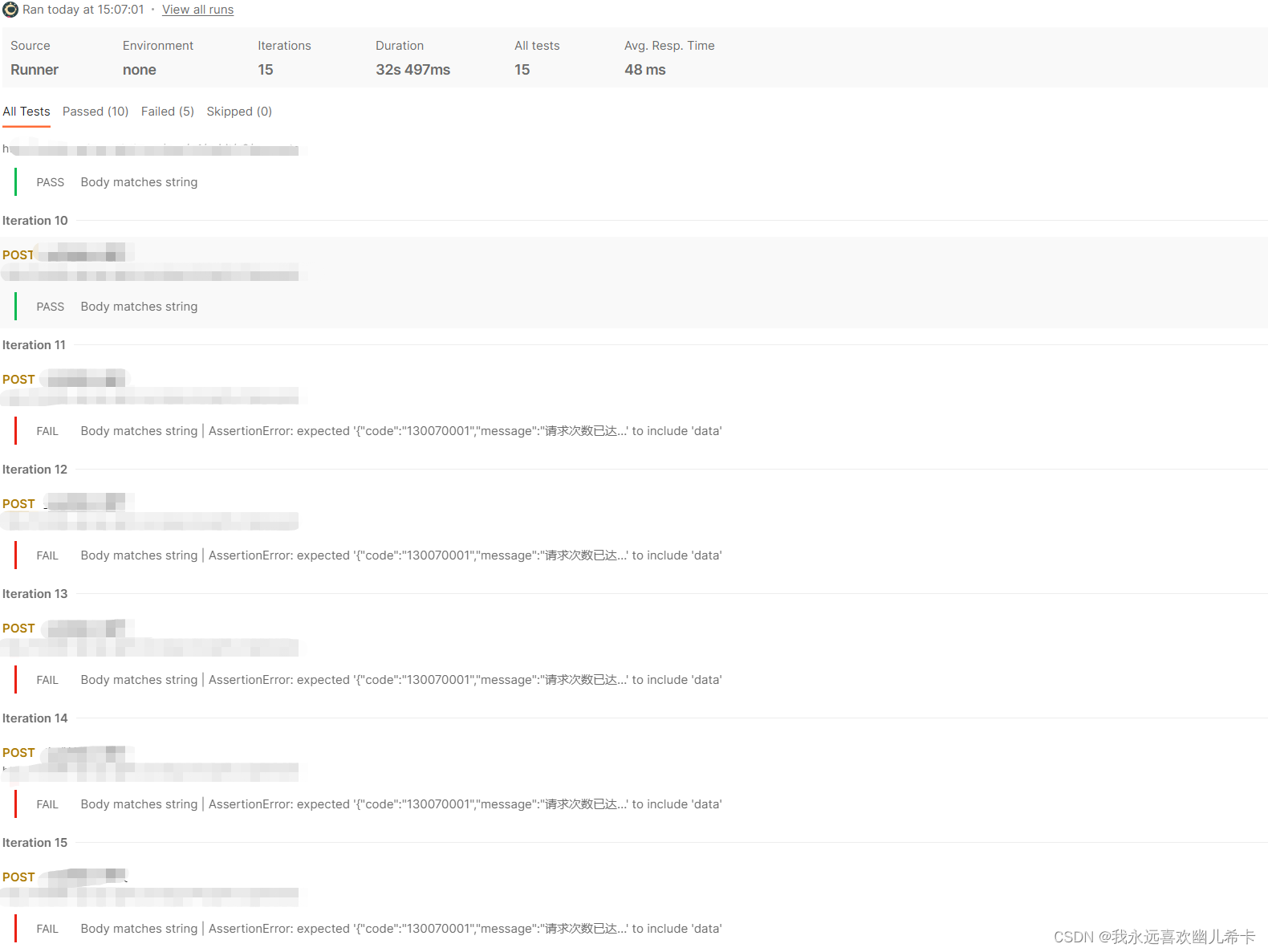【实践】SpringAOP + 自定义注解实现接口限流
目录
前置情景:
1. 对 SpringAOP 相关知识有一定理解
2. 对 自定义注解 相关知识有一定理解
3. 对 Redis + lua脚本 相关知识有一定了解
实践背景:
现某 ToC 接口存在 QPS 远高于设计预期,但内部逻辑较为复杂无法快速进行迭代优化情况
现需对此接口改造,同时为了方便其他接口后续接入同样限流功能,采用AOP+自定义注解+Redis实现
实践过程:
1. 准备redis
import lombok.extern.slf4j.Slf4j;
import org.springframework.stereotype.Component;
import redis.clients.jedis.JedisPool;
import java.util.List;
@Slf4j
@Component
public class RedisComponent {
protected JedisPool jedisPool;
@SuppressWarnings("SpringJavaInjectionPointsAutowiringInspection")
public RedisComponent(JedisPool jedisPool) {
this.jedisPool = jedisPool;
}
public Long eval(final String script, final List<String> keys, final List<String> args) {
Object result = RedisCaller.call(this.jedisPool, (jedis) -> jedis.eval(script, keys, args));
return Long.parseLong(String.valueOf(result));
}
}
注:RedisCaller为公司内部工具类,本质还是为了执行 jedis.eval(),使用其他工具类平替即可
2. 准备自定义注解 + 枚举
import java.lang.annotation.*;
@Inherited
@Documented
@Retention(RetentionPolicy.RUNTIME)
@Target({ElementType.METHOD, ElementType.TYPE})
public @interface RateLimit {
/**
* 场景prefix
*/
RateLimiterPrefixEnum prefix() default RateLimiterPrefixEnum.DEFAULT;
/**
* 资源key
*/
String key() default "";
/**
* 给定的时间段
* 单位秒
*/
int period() default 15;
/**
* 最多的访问限制次数
*/
int count() default 5;
/**
* 类型
*/
LimitType limitType() default LimitType.CUSTOMER;
}
import com.google.common.collect.Maps;
import java.util.Map;
public enum RateLimiterPrefixEnum {
/**
* 默认
*/
DEFAULT(0, "default"),
/**
* TEST
*/
TEST(1, "test");
private final Integer code;
private final String desc;
private static Map<Integer, RateLimiterPrefixEnum> map;
RateLimiterPrefixEnum(Integer code, String desc) {
this.code = code;
this.desc = desc;
}
static {
map = Maps.newHashMap();
for (RateLimiterPrefixEnum prefixEnum : RateLimiterPrefixEnum.values()) {
map.put(prefixEnum.getCode(), prefixEnum);
}
}
public Integer getCode() {
return this.code;
}
public String getDesc() {
return this.desc;
}
public static RateLimiterPrefixEnum parse(Integer code){
return map.get(code);
}
}
public enum LimitType {
/**
* 自定义key
*/
CUSTOMER,
/**
* 根据请求者IP
*/
IP;
}
3. 准备切面
import com.fasterxml.jackson.core.type.TypeReference;
import com.fasterxml.jackson.databind.ObjectMapper;
import com.google.common.collect.ImmutableList;
import com.google.common.collect.Lists;
import lombok.extern.slf4j.Slf4j;
import org.apache.commons.lang3.StringUtils;
import org.aspectj.lang.ProceedingJoinPoint;
import org.aspectj.lang.annotation.Around;
import org.aspectj.lang.annotation.Aspect;
import org.aspectj.lang.reflect.MethodSignature;
import org.springframework.beans.factory.annotation.Value;
import org.springframework.core.annotation.Order;
import org.springframework.stereotype.Component;
import org.springframework.web.context.request.RequestContextHolder;
import org.springframework.web.context.request.ServletRequestAttributes;
import javax.servlet.http.HttpServletRequest;
import java.lang.reflect.Method;
import java.util.List;
import java.util.Map;
import java.util.Objects;
@Slf4j
@Aspect
@Component
@Order(value = 1)
public class RateLimiterAspect {
private static final String UNKNOWN = "unknown";
private static final String PERIOD = "period";
private static final String COUNT = "count";
private static final String REDIS_SCRIPT;
private final RedisComponent redisComponent;
@Value("${app.limit.config.map}")
private String limitConfigMapJson;
static {
// 构建lua脚本
REDIS_SCRIPT = "local c" +
"\nc = redis.call('get', KEYS[1])" +
// 调用不超过最大值,则直接返回
"\nif c and tonumber(c) > tonumber(ARGV[1]) then" +
"\nreturn c;" +
"\nend" +
// 执行计算器自加
"\nc = redis.call('incr', KEYS[1])" +
"\nif tonumber(c) == 1 then" +
// 从第一次调用开始限流,设置对应键值的过期
"\nredis.call('expire', KEYS[1], ARGV[2])" +
"\nend" +
"\nreturn c;";
}
public RateLimiterAspect(RedisComponent redisComponent) {
this.redisComponent = redisComponent;
}
/**
* 限流拦截器
*
* @param pjp 连接点
* @return java.lang.Object
*/
@Around("execution(public * a.b.c..*Controller.*(..)) && @annotation(自定义注解的全限定类名)")
public Object limitInterceptor(ProceedingJoinPoint pjp) throws Throwable {
MethodSignature signature = (MethodSignature) pjp.getSignature();
Method method = signature.getMethod();
RateLimit limit = method.getAnnotation(RateLimit.class);
// 组装参数,优先取配置中对应场景的限流配置,没有就取接口上的兜底配置
Map<String, Map<String, Integer>> configMap =
new ObjectMapper().readValue(limitConfigMapJson, new TypeReference<Map<String, Map<String, Integer>>>(){});
Map<String, Integer> periodCountMap = configMap.get(limit.prefix().getDesc() + "_" + limit.key());
int limitPeriod = Objects.nonNull(periodCountMap) && Objects.nonNull(periodCountMap.get(PERIOD)) ?
periodCountMap.get(PERIOD) : limit.period();
int limitCount = Objects.nonNull(periodCountMap) && Objects.nonNull(periodCountMap.get(COUNT)) ?
periodCountMap.get(COUNT) : limit.count();
List<String> args = Lists.newArrayList(Integer.toString(limitCount), Integer.toString(limitPeriod));
ImmutableList<String> keys = this.getLimitKey(limit);
Long count = redisComponent.eval(REDIS_SCRIPT, keys, args);
// 如果达到限流数则抛出异常
if(count != null && count.intValue() <= limitCount) {
return pjp.proceed();
} else {
throw new AppGatewayException(AppGatewayErrorCode.REQ_RATE_LIMIT_ERROR, "请求次数已达上限");
}
}
/**
* 获取各场景限流key
*
* @param limit 方法注解配置
* @return com.google.common.collect.ImmutableList<java.lang.String>
*/
private ImmutableList<String> getLimitKey(RateLimit limit) {
String key = null;
LimitType limitType = limit.limitType();
switch (limitType) {
case IP:
key = getIpAddress();
break;
case CUSTOMER:
// 可以自定义限流
key = limit.key();
break;
default:
break;
}
return ImmutableList.of(StringUtils.join(limit.prefix(), key));
}
/**
* 获取请求的ip
*
* @return 获取请求的ip
*/
public String getIpAddress() {
HttpServletRequest request = ((ServletRequestAttributes) Objects.requireNonNull(RequestContextHolder.getRequestAttributes())).getRequest();
String ip = null;
//X-Forwarded-For:Squid 服务代理
String ipAddresses = request.getHeader("X-Forwarded-For");
if (ipAddresses == null || ipAddresses.length() == 0 || UNKNOWN.equalsIgnoreCase(ipAddresses)) {
//Proxy-Client-IP:apache 服务代理
ipAddresses = request.getHeader("Proxy-Client-IP");
}
if (ipAddresses == null || ipAddresses.length() == 0 || UNKNOWN.equalsIgnoreCase(ipAddresses)) {
//WL-Proxy-Client-IP:weblogic 服务代理
ipAddresses = request.getHeader("WL-Proxy-Client-IP");
}
if (ipAddresses == null || ipAddresses.length() == 0 || UNKNOWN.equalsIgnoreCase(ipAddresses)) {
//HTTP_CLIENT_IP:有些代理服务器
ipAddresses = request.getHeader("HTTP_CLIENT_IP");
}
if (ipAddresses == null || ipAddresses.length() == 0 || UNKNOWN.equalsIgnoreCase(ipAddresses)) {
//X-Real-IP:nginx服务代理
ipAddresses = request.getHeader("X-Real-IP");
}
//有些网络通过多层代理,那么获取到的ip就会有多个,一般都是通过逗号(,)分割开来,并且第一个ip为客户端的真实IP
if (ipAddresses != null && ipAddresses.length() != 0) {
ip = ipAddresses.split(",")[0];
}
//还是不能获取到,最后再通过request.getRemoteAddr();获取
if (ip == null || ip.length() == 0 || UNKNOWN.equalsIgnoreCase(ipAddresses)) {
ip = request.getRemoteAddr();
}
return ip;
}
}注:
1. 配置文件中需添加 app.limit.config.map = {"test_generate":{"period":管控时间,"count":上限次数}}
2. 若出现 "error Type referred to is not an annotation type: xxx" 报错,请检查环绕通知中路径是否正确
4. 在controller接口上增加自定义注解
import io.swagger.annotations.ApiOperation;
import lombok.extern.slf4j.Slf4j;
import org.springframework.web.bind.annotation.PostMapping;
import org.springframework.web.bind.annotation.RequestMapping;
import org.springframework.web.bind.annotation.RequestPart;
import org.springframework.web.bind.annotation.RestController;
import javax.annotation.Resource;
@Slf4j
@RestController
@RequestMapping("/test")
public class TestController {
@Resource
private TestBizService testBizService;
/**
* test(增加流量管控)
*
* @param req 请求json
* @return TestDTO
*/
@NoSign
@PostMapping("/generate")
@ApiOperation(value = "generate")
@RateLimit(prefix = RateLimiterPrefixEnum.TEST, key = "generate", limitType = LimitType.CUSTOMER)
public TestDTO generate(@RequestPart TestRequest req) {
try {
return testBizService.generate(req);
} catch (Exception e) {
log.error("generate test error", e);
return new TestDTO();
}
}
}注:若出现 "getInputStream() has already been called for this request" 说明请求中数据已被获取过了,请确认是否有其他拦截器等配置,并自行百度解决
5. 使用postman验证效果

总结:
需求其实很简单,但为了方便后续其他接口快速接入限流能力,还是使用了比较复杂但泛用的实现方式,正好修补一下自己的知识漏洞,也挺好的。
愿这篇实践能对后来者有所帮助























 768
768











 被折叠的 条评论
为什么被折叠?
被折叠的 条评论
为什么被折叠?








